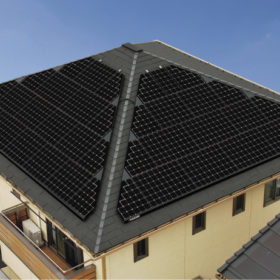
The annual installed PV capacity for Japan is expected to be 7 GW (DC) in 2019, according to RTS Corp. Cumulative PV installed capacity now stands at 63 GW. In addition to the robust introduction of small-scale PV projects, the development of already approved large-scale PV projects under the FIT program was advanced by the end of the year, say RTS analysts Takashi Ohigashi and Izumi Kaizuka.
From pv magazine 02/2020
The annual installed PV capacity for Japan is expected to be 7 GW (DC) in 2019, according to RTS Corp. Cumulative PV installed capacity now stands at 63 GW. In addition to the robust introduction of small-scale PV projects, the development of already approved large-scale PV projects under the FIT program was advanced by the end of the year, say RTS analysts Takashi Ohigashi and Izumi Kaizuka. This corresponds to measures for approved projects that have not started operating. Also, the authorities continued to promote new installations in various sectors related to PV.
Japan’s Ministry of Economy, Trade and Industry (METI) has indicated that it continues to support competitive power sources (large-scale PV and wind power) based on the feed-in premium (FIP) program, alongside a drastic review of the FIT program until the end of fiscal 2020. Independent from the FIT program, it also maintains a framework of the FIT program for locally used power (small-scale PV, etc.), to set requirements for approving installations as locally used power sources.
In order to secure the trust of local communities, METI has also compiled funding schemes to cover the cost of disposal of PV facilities at end of life. In addition, considering damages and blackouts caused by natural disasters such as earthquakes and typhoons, METI is promoting efforts to strengthen resilience in the energy system, including the development of safety measures and next-generation electricity networks.
Cutting curtailment
As for the electric power business, based on the trends of making renewable energy a mainstream power source, electric companies conducted organizational reforms to promote efforts in renewable energy in 2019. Also, power purchase agreements for surplus electricity from post-FIT residential PV systems have been announced, and competition among electric companies and power producers and suppliers (PPS) has started. In Japan’s Kyushu region, output curtailment of renewable energy was also conducted approximately 60 times between January and December 2019, as in the previous year. Regional utility Kyushu Electric Power started a new program to reduce output curtailment amount by approximately 9%.
Throughout the year, various new business models emerged, including the trend of focusing on the self-consumption market by shifting from dependence on the FIT program – a response to post-FIT residential PV systems and resilience. The introduction of energy systems combining energy generation and energy storage continues to move toward achieving net zero energy consumption, and the development of the zero-yen installation model power purchase agreements through third-party ownership (TPO) is effectively disseminating these efforts.
Self-consumption
The current year is expected to be the point – as an early stage in the development of a full-fledged post-FIT market – when PV, storage battery systems, and energy management systems utilizing new business models are developed. In the background, the focus will be on the following three points: 1) progress in cost reductions for renewable energy power generation systems, including PV systems; 2) an increase in demand for electricity from renewable energy sources such as the RE100 initiative; and 3) growing demand to prioritize disaster-prevention measures and resilience in the supply chain and local communities. PV systems will be selected as the leading distributed power source.
By promptly achieving market independence among major renewable energy sources, it is expected that 2020 will be a year of great progress, when the original value of PV systems to Japan’s energy landscape will be further recognized.
About the authors
Izumi Kaizuka is the manager of the research division at RTS Corp., a PV consulting firm in Tokyo with more than 35 years of history. She is also a member of The PV Market Alliance (PVMA). Kaizuka has led a number of research projects for the Ministry of Economy, Trade and Industry (METI), the New Energy and Industrial Technology Development Organization (NEDO), and other government organizations. She has been Japan’s representative for the IEA PVPS Task 1 (Group for PV strategic analysis and communication) since 2003. She is also one of the authors of the IEA PVPS Trends Report, which describes conditions in the PV market.
Takahashi Ohigashi is a director and senior analyst at RTS Corp., and has been with the company since 1995. Ohigashi is a member of the Japan Society for the Promotion of Science, and sits on a review board that selects projects for new energy technologies. He has published a wide range of research PV technology and markets, including studies conducted for Japan’s Ministry of Trade and Industry and the New Energy and Industrial Technology Development Organization (NEDO).
Japan’s 2019 PV highlights by segment
| National government |
|
| Municipalities |
|
| Electric companies |
|
| Industry |
|
| Power generation business |
|
| Support service for power generation business |
|
| Finance-related |
|
| Technology development |
|
| Installation trend |
|
Lắp đặt điện mặt trời Khải Minh Tech
https://ift.tt/2X7bF6x
0906633505
info.khaiminhtech@gmail.com
80/39 Trần Quang Diệu, Phường 14, Quận 3
Lắp đặt điện mặt trời Khải Minh Tech
https://ift.tt/2ZH4TRU
Không có nhận xét nào:
Đăng nhận xét